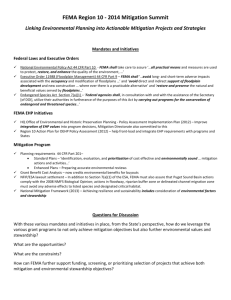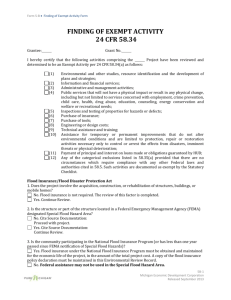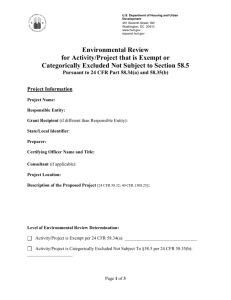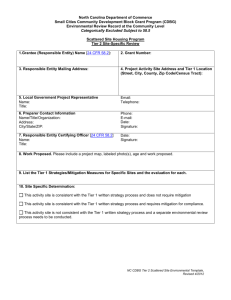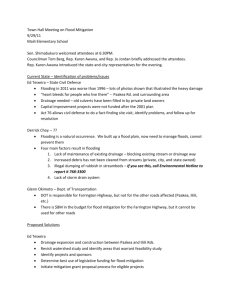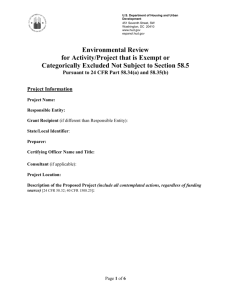Site Specific Checklist Sample
advertisement
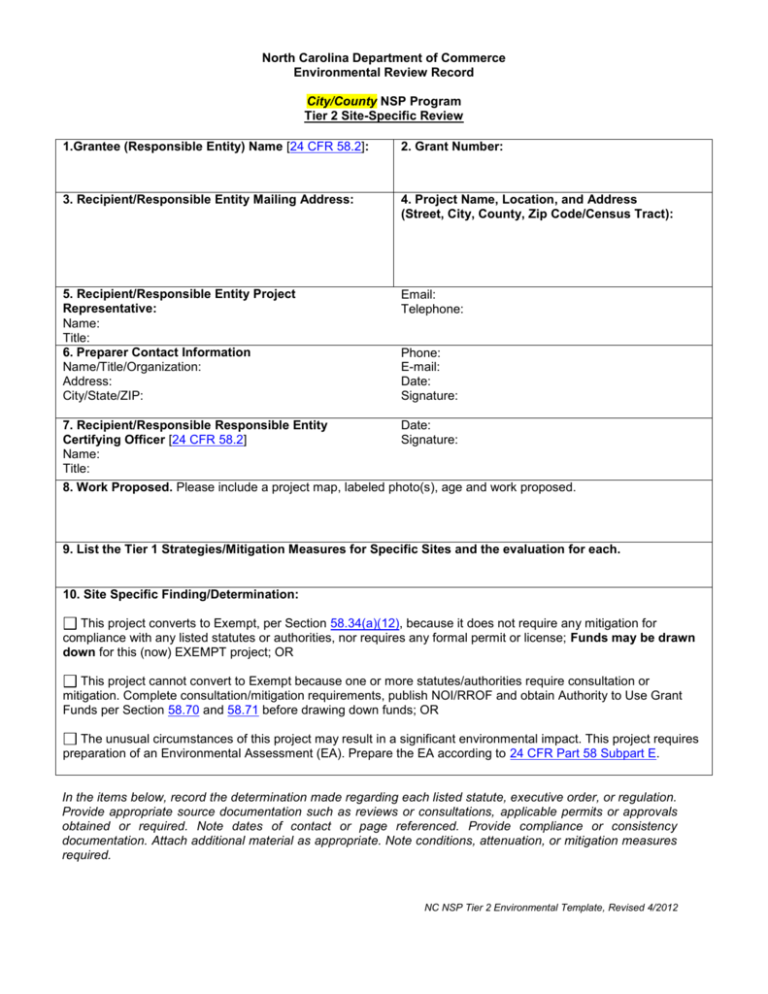
North Carolina Department of Commerce Environmental Review Record City/County NSP Program Tier 2 Site-Specific Review 1.Grantee (Responsible Entity) Name [24 CFR 58.2]: 2. Grant Number: 3. Recipient/Responsible Entity Mailing Address: 4. Project Name, Location, and Address (Street, City, County, Zip Code/Census Tract): 5. Recipient/Responsible Entity Project Representative: Name: Title: 6. Preparer Contact Information Name/Title/Organization: Address: City/State/ZIP: Email: Telephone: Phone: E-mail: Date: Signature: 7. Recipient/Responsible Responsible Entity Date: Certifying Officer [24 CFR 58.2] Signature: Name: Title: 8. Work Proposed. Please include a project map, labeled photo(s), age and work proposed. 9. List the Tier 1 Strategies/Mitigation Measures for Specific Sites and the evaluation for each. 10. Site Specific Finding/Determination: This project converts to Exempt, per Section 58.34(a)(12), because it does not require any mitigation for compliance with any listed statutes or authorities, nor requires any formal permit or license; Funds may be drawn down for this (now) EXEMPT project; OR This project cannot convert to Exempt because one or more statutes/authorities require consultation or mitigation. Complete consultation/mitigation requirements, publish NOI/RROF and obtain Authority to Use Grant Funds per Section 58.70 and 58.71 before drawing down funds; OR The unusual circumstances of this project may result in a significant environmental impact. This project requires preparation of an Environmental Assessment (EA). Prepare the EA according to 24 CFR Part 58 Subpart E. In the items below, record the determination made regarding each listed statute, executive order, or regulation. Provide appropriate source documentation such as reviews or consultations, applicable permits or approvals obtained or required. Note dates of contact or page referenced. Provide compliance or consistency documentation. Attach additional material as appropriate. Note conditions, attenuation, or mitigation measures required. NC NSP Tier 2 Environmental Template, Revised 4/2012 11. Planning and Zoning a. Is the project in compliance or conformance with local zoning? Yes No Explain: b. Is the proposal consistent or compatible with completed components of the local or regional comprehensive plan? Yes No Explain: c. Are there any unresolved conflicts concerning the use of the site? Yes No Explain: d. Does the project require mitigation in regards to local zoning? Yes No e. Comments and Source Documentation: 12. Air Quality [Clean Air Act, Sections 176 (c) and (d), and 40 CFR 6, 51, 93] a. Is the project within a "non-attainment" or "maintenance" area identified in the air quality State Implementation Plan (SIP)? Yes No b. Does the project involve transportation facilities? c. Yes No Does the project comply with the North Carolina Air Quality Implementation Plan (SIP)? Yes No Explain: d. Does the project require mitigation in regards to air quality? Yes No e. Comments and Source Documentation: 13. Coastal Zone Management Act and Coastal Barriers [Sections 307(c),(d)] a. Is the project listed in a Coastal Area Management Act (CAMA) county? Yes No b. Does the project involve new construction, land conversion, major rehabilitation, and substantial improvement activities? Yes No c. Does the project require a consistency review with NCDCM? Yes No Explain: If yes to c, please provide an analysis in the space below of how the proposed financial assistance would result in a project (when constructed) that would be consistent with the State’s coastal management program. d. Is the project located within a coastal barrier designated on a current FEMA flood map or Department of Interior coastal barrier resources map ? Yes No e. Comments and Source Documentation: 14. Historic Preservation [36 CFR 800] a. Have you notified the State Historic Preservation Office (SHPO) and/or the Advisory Council on Historical Places (AHCP) of the project and requested their comments? NC NSP Tier 2 Environmental Template, Revised 4/2012 Yes b. Yes c. No Is the property listed on or eligible for listing on the National Register of Historic Places? No Is the property located within or directly adjacent to an historic district? Yes No d. Does the property’s area of potential effects include an historic district or property? Yes No e. Does the project require mitigation in regard to historic preservation? Yes No f. Comments and Source Documentation: 15. Cultural Preservation [36 CFR 800] a. What kind, if any, site preparation has already been conducted on the site? b. Has the area been previously surveyed by an archaeologist? Yes No If so, give name of principal investigator and date of survey: c. Have you notified the Catawba Indian Nation Tribal Historic Preservation Officer of the project and requested their comments? Yes No d. Have you notified the Eastern Band of Cherokee Indians Tribal Historic Preservation Officer of the project and requested their comments? Yes No e. Have you notified the Tuscarora Nation of New York Tribal Historic Preservation Officer of the project and requested their comments? Yes No f. Does the project require mitigation in regard to cultural preservation? Yes No g. Comments and Source Documentation: 16. Floodplain Management and Insurance (24 CFR Part 55, E.O. 11988) a. Is the project area located within a 100-year floodplain (500-year for “critical actions”) designated on a current FEMA flood map? Yes No b. Identify and attach the FEMA flood map used to make this finding with the project site(s) clearly marked: i. Community Name and Number: ii. Map Panel Number and Date of Map Panel: c. Is the 8 step decision making process required for this project (§ 55.20)? Yes No d. Is there a building located or to be located within a Special Flood Hazard Area identified on a current Flood Insurance Rate Map (FIRM)? Yes No NC NSP Tier 2 Environmental Template, Revised 4/2012 e. Is flood insurance protection required for this project? f. Yes Does the project require floodplain mitigation measures? No Yes Explain: No g. Comments and Source Documentation: 17. Protection of Wetlands (E.O. 11990) a. Are there drainage ways, streams, rivers, or coastlines on or near the site? Yes b. Are there ponds, marshes, bogs, swamps, or other wetlands on or near the site? c. Are there soils or vegetation characteristic of wetlands on or near the site? d. Does the project have the potential to affect or be affected by a wetland? No Yes Yes No No Yes No e. For projects involving ground disturbance, are there any streams that surface waters drain into? (Attach a map). Yes No f. For projects proposing ground disturbance, is the project located within a wetland designated on a National Wetland Inventory Map of the Department of Interior? Yes No g. Is the 8 step decision-making process required for this project (§ 55.20)? h. Does the project involve any impoundment or withdrawal of water? If so, please specify and describe with appropriate maps. Yes Yes No No i. Is the proposed project or activity subject to compliance with conditions set forth by the U.S. Army Corps of Engineers, concerning permits for dredge and fill activity? Yes No j. Does the project require wetland mitigation measures? k. Comments and Source Documentation: Yes No 18. Wild and Scenic Rivers Act [16 U.S.C. 1271 et seq. Sections 7 (b), (c)] a. Will the project affect a Wild and Scenic River or a river in the Nationwide Rivers inventory? Yes No b. Does the project require mitigation measures in regard to wild and scenic rivers? c. Yes No Comments and Source Documentation: 19. Noise Abatement [24 CFR 51, Subpart B] a. Is the project located within 5 miles of a civil airport? Yes b. Is the project located within 15 miles of a military airfield? No Yes No NC NSP Tier 2 Environmental Template, Revised 4/2012 c. Is the project located within 1,000 feet of a major highway or busy road? d. Is the project located within 3,000 feet of a railroad? Yes e. Does the project involve development of noise-sensitive uses? Yes No No Yes No If yes to e and any of a-d, calculate and attach the Day/Night Noise Level (DNL) calculator or Noise Assessment Guidelines worksheets. f. Describe any temporary noise resulting from the project: g. Does the project require noise attenuation or mitigation measures? Yes No h. Comments and Source Documentation: 20. Airport Hazards [24 CFR Part 51, Subpart D] a. Is the project within 3,000 feet from the end of a runway at a civil airport? Yes No b. Is the project within 2 ½ miles from the end of a runway at a military airfield? Yes No c. If the project is located in a Runway Clear Zone or Clear Zone, will the project be frequently used or occupied by people? Yes No d. Does the project require compliance with airport runway clear zones? Yes No e. Comments and Source Documentation: 21. Explosive and Flammable Hazard Operations [24 CFR Part 51, Subpart C] a. Is this a construction or rehabilitation modernization project that will increase the number of people using the structure? Yes No b. Is this a rehabilitation/modernization project that will make a vacant building habitable? Yes No c. If yes to a or b, are there industrial facilities handling explosive or fire-prone materials such as liquid propane, gasoline or other storage tanks 1 mile from, adjacent to, or visible from the project site? Yes No d. If yes to c, use the HUD Hazards Guide and attach Acceptable Separation Distance documentation. f. Does the project require mitigation for hazards? Yes No g. Comments and Source Documentation: 22. Toxic Chemicals and Radioactive Materials [24 CFR 58.5(i)] a. Is the project near an industry disposing of chemicals or hazardous wastes? Yes No NC NSP Tier 2 Environmental Template, Revised 4/2012 b. Is the site listed on an EPA Superfund National Priorities or CERCLA or equivalent State list? Yes No c. Is the site located within 3,000 feet of a toxic or solid waste landfill site? Yes No d. Does the site have an underground storage tank? Yes No e. Does the project require a Phase I ASTM report? Yes No f. Does the project require a Phase II ASTM report? Yes No g. Does the project require mitigation or remediation measures for toxins? Yes No h. Comments and Source Documentation: 23. Endangered Species [50 CFR part 402] a. Will there be any ground disturbance, vegetation removal, or unusually loud noise with this project? Yes No b. Review the Department of Interior list of Endangered Species and Critical Habitats list for the area. Is the project likely to affect any state or federally listed or proposed endangered or threatened species or critical habitats? Yes No If yes attach consultation with the Fish and Wildlife Service. c. For projects involving ground disturbance or noise, what other classes of wildlife are known to exist in the general area? d. Comments and Source Documentation: 24. Sole Source Aquifers: [40 CFR 149] a. Will the proposed project affect a sole source aquifer? Yes No b. Comments and Source Documentation: There are no sole source aquifers in North Carolina. http://www.epa.gov/region4/water/groundwater/r4ssa.html 25. Farmland Protection [7 CFR Part 658] a. Will the proposed project be located on or directly adjacent to land that is categorized as prime, unique, or of State or local importance? Yes No b. Does the project involve ground disturbance? c. Does the project involve land conversion? Yes Yes No No If yes, will the project location, construction, or activities of project users adversely affect farmland on or near the site by conversion? Yes No NC NSP Tier 2 Environmental Template, Revised 4/2012 d. Does the project involve drainage that will adversely affect farmland? Yes No e. Will the project create problems by introducing nuisance species of vegetation which may spread to adjacent farmland? Yes No f. For projects involving ground disturbance, describe the topography in terms of slope, soil type, and vegetation. g. Does the project require compliance mitigation with the Farmland Protection Policy Act and HUD policy memo? Yes No h. Comments and Source Documentation: 26. Environmental Justice [E.O. 12898] a. Is the project located in a predominantly minority area? Yes No b. Is the project located in a predominantly low-income area? c. Yes No Does this project site area have disproportionate adverse environmental effects on minority and low-income populations relative to the community-at-large? Yes No d. Is the project site(s) subject to man-made hazards that produce high levels of pollution? e. Does the project require compliance mitigation in regard to environmental justice? f. Yes Yes No No Comments and Source Documentation: NC NSP Tier 2 Environmental Template, Revised 4/2012 COMPLIANCE DOCUMENTATION CHECKLIST [24 CFR Part 58.6] Recipient/Responsible Entity Name: Project Name: Grant Number: Site Address: The Environmental Review Record (ERR) must contain a well organized written record of the process and determinations made under this section. The Flood Disaster Protection Act of 1973 1. Does the project involve acquisition, construction or rehabilitation of structures located in a FEMA-identified Special Flood Hazard Area as designated on a current FEMA Flood Map? No - Source Documentation: Identify and attach the FEMA flood map used to make your finding. Yes – Continue to Question 2. 2. Is the community participating in the National Flood Insurance Program (or has less than one year passed since FEMA notification of Special Flood Hazards)? Yes - Flood Insurance under the National Flood Insurance Program must be obtained and maintained for the economic life of the project, in the amount of the total project cost. A copy of the flood insurance policy declaration is to be obtained as a condition of the approval of financial assistance to the property owner and must be in file. No - Federal assistance may not be used in the Special Flood Hazards Area unless the community is participating in the National Flood Insurance Program. The Coastal Barrier Resources Act 1. Is the project located in a coastal barrier resource area? Not Applicable - Non-Coastal County (attach source documentation) No – Coastal counties must identify and attach the source documentation: Yes - Federal assistance may not be used in such an area. Runway Clear Zones and Clear Zones 1. Is the project located within 3,000 feet from the end of the runway at a civil airport? Is the project located within 2.5 miles from the end a runway at a military airfield? No – Attach Source Documentation: Yes – Continue to Question 2. 2. Does the project involve the sale or acquisition of existing property within a Civil Airport's Runway Clear Zone or a Military Installation's Clear Zone? No - Attach Source Documentation: (Project complies with 24 CFR 51.303[a] [3]). Yes – A disclosure statement must be provided to buyer and a copy of the signed disclosure must be maintained in this Environmental Review Record In all cases involving HUD assistance, subsidy, or insurance for the purchase or sale of an existing property in a runway Clear Zone or Clear Zone, the responsible entity shall advise the buyer that the property is in a runway clear zone or clear zone, what the implications of such a location are, and that there is a possibility that the property may, at later date, be acquired by the airport. The buyer must sign a statement acknowledging receipt of this information. _ ____________________________________ _______________________ Recipient/Responsible Entity Certifying Official Name and Title (Please Print) __ __________________________________ _______________________ Recipient/Responsible Entity Certifying Official Signature and Date NC NSP Tier 2 Environmental Template, Revised 4/2012
